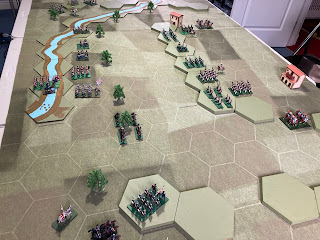Bob Black popped over for a few hours and we had agreed to give Perry's Travel Battle an airing. I have had the game, in fact two sets, for a couple of years, and although I had painted some of the figures I had not actually tried the game.
We had more troops than needed for the game, but we decided to play it as it comes out of the box. Bob took the French army and I the Austrians. The game starts with a random selection of the playing area, decided by a dice, with the two boards set up side by side. Each army has three Brigades formed as desired by the players. Then in turn each player places a brigade on his edge of the board. This is what the initial set up looked like:
My Austrians are nearest to the camera, and I had organised my army with two infantry brigades with artillery support and a cavalry brigade. Bob, on the other hand, went for three mixed brigades with infantry and cavalry.
My side of the board had some key defensive positions, with a walled farm on my right and high ground behind, a small farm in the centre in a flat area of land. On my left was a large wood and more high ground. Bob, however, had high ground in the centre, a village on his right and a wood on his left. I decided from the outset that I would defend the the walled farm and the wood, keeping my artillery on the high ground. The cavalry would work best on the flat ground in the centre.
The village, with a French Brigade deployed behind:
The Austrians move forward to take the high ground and advance towards the walled farm beyond, the French can just be seen beyond the wood:
Early on, Bob pushes his heavy cavalry forward, but has overlooked the need to keep them in contact with the Brigade commander. They will not be able to move further until he catches them up, but they can fight if attacked. However, he has left them very exposed with the Austrian cavalry to their front.
On the next move the Austrian cavalry brigade charged forward, with their brigadier and slammed into the French:
Fighting is done on the basis of the highest score on the dice, with elite troops and heavy cavalry getting a second roll option. The Austrians did not do as well as expected. They lose a heavy regiment and one light cavalry regiment routs. The French lose a regiment too.
A second round of combat sees the destruction of the French cavalry attack and the Austrian cavalry pull back and reform.
The French attack towards the walled farm also comes unstuck as they lose a cavalry regiment and two foot units, although they force one Austrian unit back to the edge of the boars upsetting the cohesion of the Austrian brigade.
In the centre French infantry push forward and are attacked by the Austrian cavalry:
The French troops are grenadiers who have some lucky rolls on the dice. They destroy one regiment of Austrian Hussars and force the remainder of the brigade back:
However, with the destruction of the French cavalry and the mauling of the French assault on the walled farm, further casualties on the French right sees that Brigade abandon their advance. They withdraw out of range:
Having had all three brigades blunted and with the threat of beer, sausages and baked potatoes for lunch Bob concedes the battle. He could have gone on fighting as to win, two complete brigades need to be destroyed.
This was an interesting experiment that provided a couple of hours of fun. The game probably moved a bit slowly as we had to consult the rules frequently. We made a few mistakes too, for example, forgetting to attempt to rally broken troops as they fled the field.
We will give the game another go in the future. We are already wondering if some micro tanks could play on the same boards!













.jpg)






















.jpg)



























